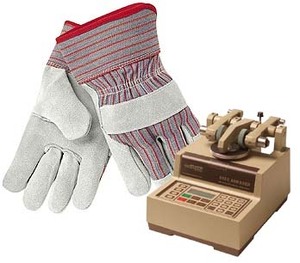Leather Safety Gloves
Rotary Abraser Quantifies Resistance to Abrasion of Safety Gloves

Situation:
A national retailer of safety equipment, MCR Safety, required performance information on several types of leather safety gloves. The test results would then be used to market the glove based upon intended application. For abrasion resistance, they turned to Taber Industries.
Analysis:
Safety gloves are typically made from three types of leather: cow, pig and goat. Each type of leather offers unique advantages and is considered to be wear resistant, so quantifying this performance validates how the gloves are marketed.
The instrument selected for conducting the tests was the Taber Rotary Platform Abraser with a procedure based on ASTM D7255 “Standard Test Method for Abrasion Resistance of Leather (Rotary Platform, Double-head Method)”. Results of this ASTM test are typically the number of cycles required to break through the finished surface, or a judgment of the specimen surface appearance after a fixed number of cycles. To get a comparative value of the durability of the leather, Taber’s approach was to test each specimen until a hole was worn through. Each glove was opened at the seams and an S-36-1 round specimen card was attached to the inside palm of each glove. The specimen was cut with scissors to obtain a 4” diameter specimen. Utilizing both visual results and weight loss, it was easy to rank the performance of the different materials and show which were most wear resistant.
Benefit:
According to MCR Safety, leather gloves offer excellent hand protection for industrial workers while providing comfort, durability and dexterity. The customer now has a means to differentiate the types of leather used in their safety gloves. Plus, they have the ability to validate the differences in premium versus economy leather.


